A Philosophical Exploration of Self, Society, and Identity Formation
VerifiedAdded on 2023/06/10
|5
|1036
|163
Essay
AI Summary
This essay delves into the philosophical understanding of the self in relation to society, primarily through the lens of symbolic interactionism. It discusses how the self is developed through interactions with both significant and generalized others, highlighting the reciprocal relationship between the individual and society. The essay explores the concept of reflexivity, where individuals reflect on themselves as objects, and examines how the mind emerges from social interaction. It further investigates the formation of identity, emphasizing that individuals possess multiple identities shaped by social structures and shared meanings. The essay references key thinkers and concepts in symbolic interactionism to provide a comprehensive analysis of the self, society, and identity.
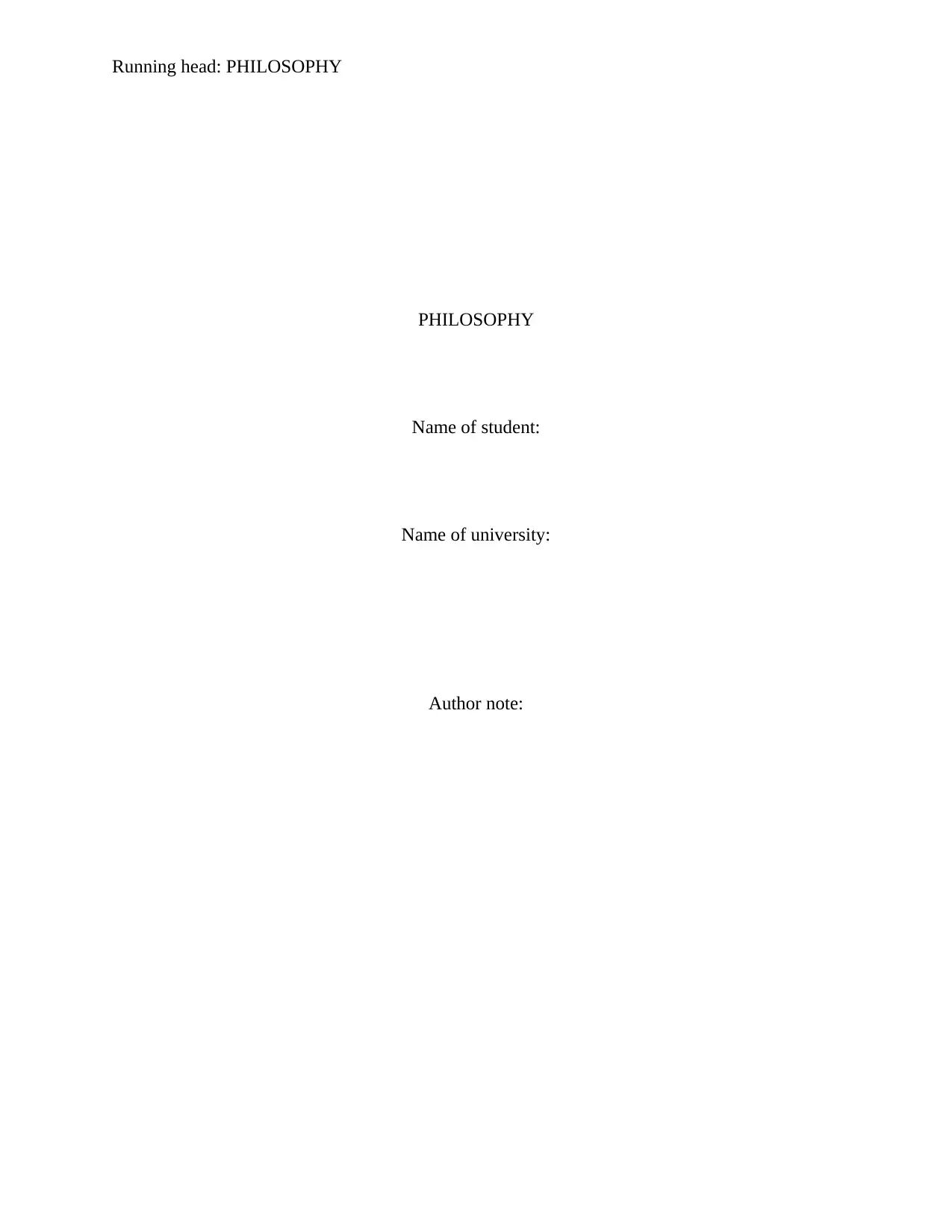
Running head: PHILOSOPHY
PHILOSOPHY
Name of student:
Name of university:
Author note:
PHILOSOPHY
Name of student:
Name of university:
Author note:
Paraphrase This Document
Need a fresh take? Get an instant paraphrase of this document with our AI Paraphraser
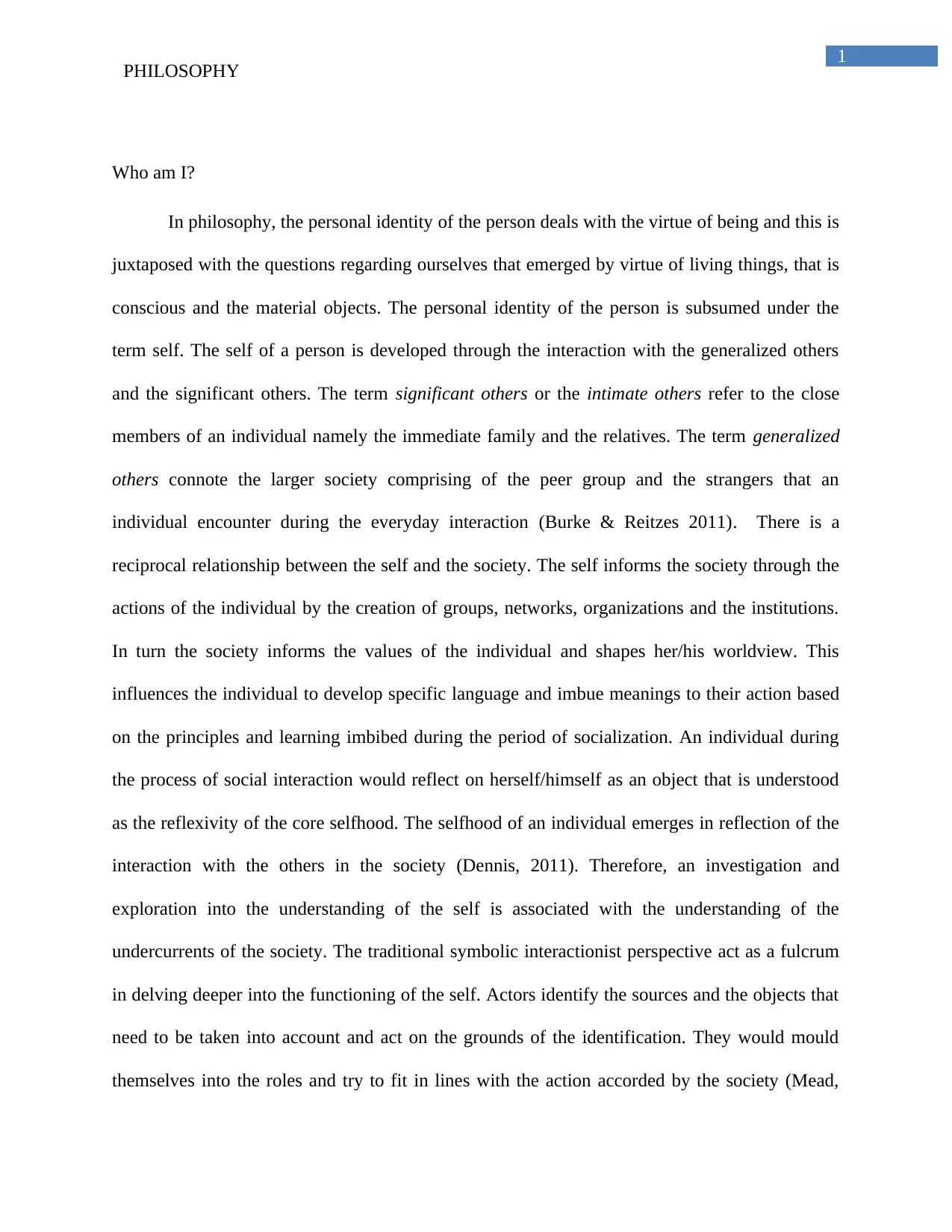
1
PHILOSOPHY
Who am I?
In philosophy, the personal identity of the person deals with the virtue of being and this is
juxtaposed with the questions regarding ourselves that emerged by virtue of living things, that is
conscious and the material objects. The personal identity of the person is subsumed under the
term self. The self of a person is developed through the interaction with the generalized others
and the significant others. The term significant others or the intimate others refer to the close
members of an individual namely the immediate family and the relatives. The term generalized
others connote the larger society comprising of the peer group and the strangers that an
individual encounter during the everyday interaction (Burke & Reitzes 2011). There is a
reciprocal relationship between the self and the society. The self informs the society through the
actions of the individual by the creation of groups, networks, organizations and the institutions.
In turn the society informs the values of the individual and shapes her/his worldview. This
influences the individual to develop specific language and imbue meanings to their action based
on the principles and learning imbibed during the period of socialization. An individual during
the process of social interaction would reflect on herself/himself as an object that is understood
as the reflexivity of the core selfhood. The selfhood of an individual emerges in reflection of the
interaction with the others in the society (Dennis, 2011). Therefore, an investigation and
exploration into the understanding of the self is associated with the understanding of the
undercurrents of the society. The traditional symbolic interactionist perspective act as a fulcrum
in delving deeper into the functioning of the self. Actors identify the sources and the objects that
need to be taken into account and act on the grounds of the identification. They would mould
themselves into the roles and try to fit in lines with the action accorded by the society (Mead,
PHILOSOPHY
Who am I?
In philosophy, the personal identity of the person deals with the virtue of being and this is
juxtaposed with the questions regarding ourselves that emerged by virtue of living things, that is
conscious and the material objects. The personal identity of the person is subsumed under the
term self. The self of a person is developed through the interaction with the generalized others
and the significant others. The term significant others or the intimate others refer to the close
members of an individual namely the immediate family and the relatives. The term generalized
others connote the larger society comprising of the peer group and the strangers that an
individual encounter during the everyday interaction (Burke & Reitzes 2011). There is a
reciprocal relationship between the self and the society. The self informs the society through the
actions of the individual by the creation of groups, networks, organizations and the institutions.
In turn the society informs the values of the individual and shapes her/his worldview. This
influences the individual to develop specific language and imbue meanings to their action based
on the principles and learning imbibed during the period of socialization. An individual during
the process of social interaction would reflect on herself/himself as an object that is understood
as the reflexivity of the core selfhood. The selfhood of an individual emerges in reflection of the
interaction with the others in the society (Dennis, 2011). Therefore, an investigation and
exploration into the understanding of the self is associated with the understanding of the
undercurrents of the society. The traditional symbolic interactionist perspective act as a fulcrum
in delving deeper into the functioning of the self. Actors identify the sources and the objects that
need to be taken into account and act on the grounds of the identification. They would mould
themselves into the roles and try to fit in lines with the action accorded by the society (Mead,
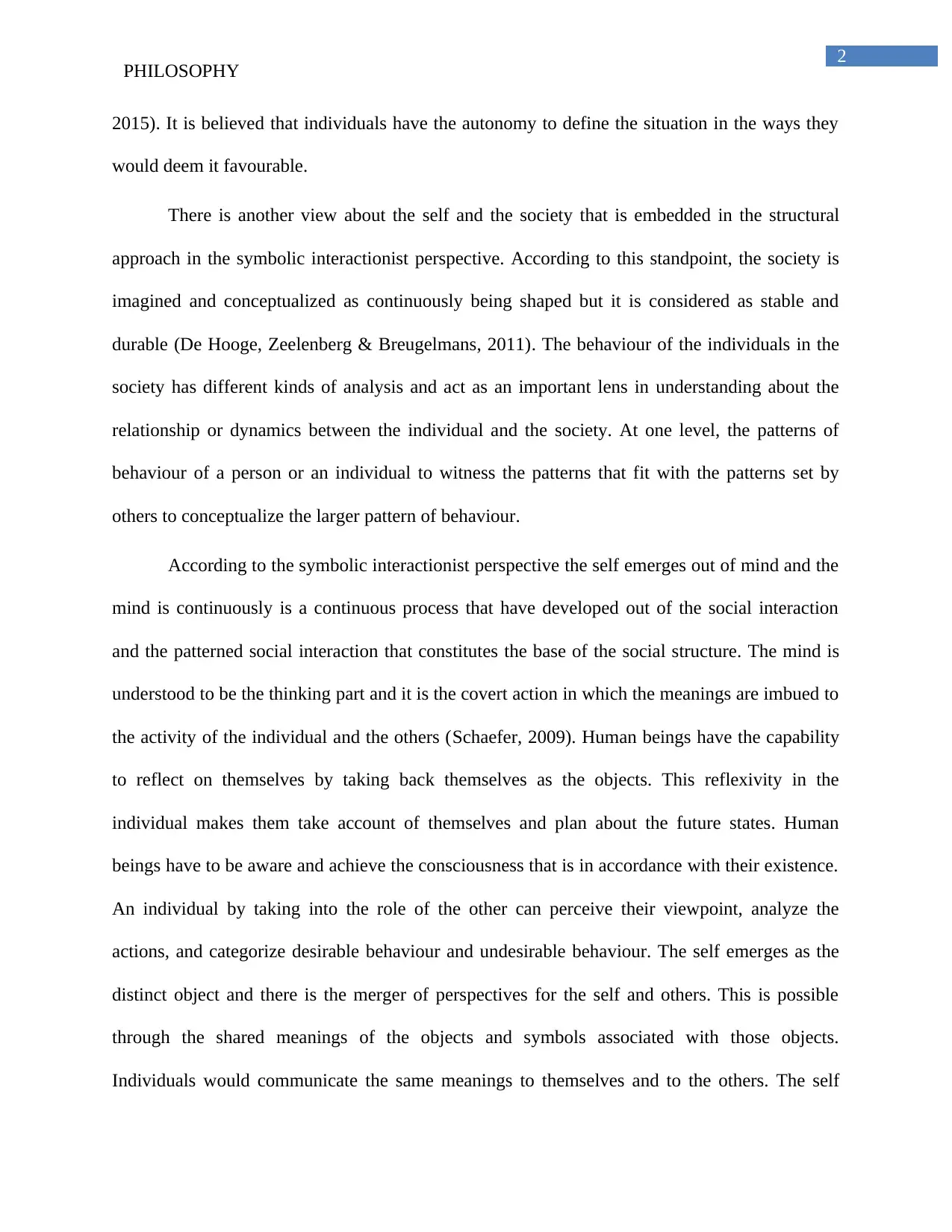
2
PHILOSOPHY
2015). It is believed that individuals have the autonomy to define the situation in the ways they
would deem it favourable.
There is another view about the self and the society that is embedded in the structural
approach in the symbolic interactionist perspective. According to this standpoint, the society is
imagined and conceptualized as continuously being shaped but it is considered as stable and
durable (De Hooge, Zeelenberg & Breugelmans, 2011). The behaviour of the individuals in the
society has different kinds of analysis and act as an important lens in understanding about the
relationship or dynamics between the individual and the society. At one level, the patterns of
behaviour of a person or an individual to witness the patterns that fit with the patterns set by
others to conceptualize the larger pattern of behaviour.
According to the symbolic interactionist perspective the self emerges out of mind and the
mind is continuously is a continuous process that have developed out of the social interaction
and the patterned social interaction that constitutes the base of the social structure. The mind is
understood to be the thinking part and it is the covert action in which the meanings are imbued to
the activity of the individual and the others (Schaefer, 2009). Human beings have the capability
to reflect on themselves by taking back themselves as the objects. This reflexivity in the
individual makes them take account of themselves and plan about the future states. Human
beings have to be aware and achieve the consciousness that is in accordance with their existence.
An individual by taking into the role of the other can perceive their viewpoint, analyze the
actions, and categorize desirable behaviour and undesirable behaviour. The self emerges as the
distinct object and there is the merger of perspectives for the self and others. This is possible
through the shared meanings of the objects and symbols associated with those objects.
Individuals would communicate the same meanings to themselves and to the others. The self
PHILOSOPHY
2015). It is believed that individuals have the autonomy to define the situation in the ways they
would deem it favourable.
There is another view about the self and the society that is embedded in the structural
approach in the symbolic interactionist perspective. According to this standpoint, the society is
imagined and conceptualized as continuously being shaped but it is considered as stable and
durable (De Hooge, Zeelenberg & Breugelmans, 2011). The behaviour of the individuals in the
society has different kinds of analysis and act as an important lens in understanding about the
relationship or dynamics between the individual and the society. At one level, the patterns of
behaviour of a person or an individual to witness the patterns that fit with the patterns set by
others to conceptualize the larger pattern of behaviour.
According to the symbolic interactionist perspective the self emerges out of mind and the
mind is continuously is a continuous process that have developed out of the social interaction
and the patterned social interaction that constitutes the base of the social structure. The mind is
understood to be the thinking part and it is the covert action in which the meanings are imbued to
the activity of the individual and the others (Schaefer, 2009). Human beings have the capability
to reflect on themselves by taking back themselves as the objects. This reflexivity in the
individual makes them take account of themselves and plan about the future states. Human
beings have to be aware and achieve the consciousness that is in accordance with their existence.
An individual by taking into the role of the other can perceive their viewpoint, analyze the
actions, and categorize desirable behaviour and undesirable behaviour. The self emerges as the
distinct object and there is the merger of perspectives for the self and others. This is possible
through the shared meanings of the objects and symbols associated with those objects.
Individuals would communicate the same meanings to themselves and to the others. The self
⊘ This is a preview!⊘
Do you want full access?
Subscribe today to unlock all pages.

Trusted by 1+ million students worldwide
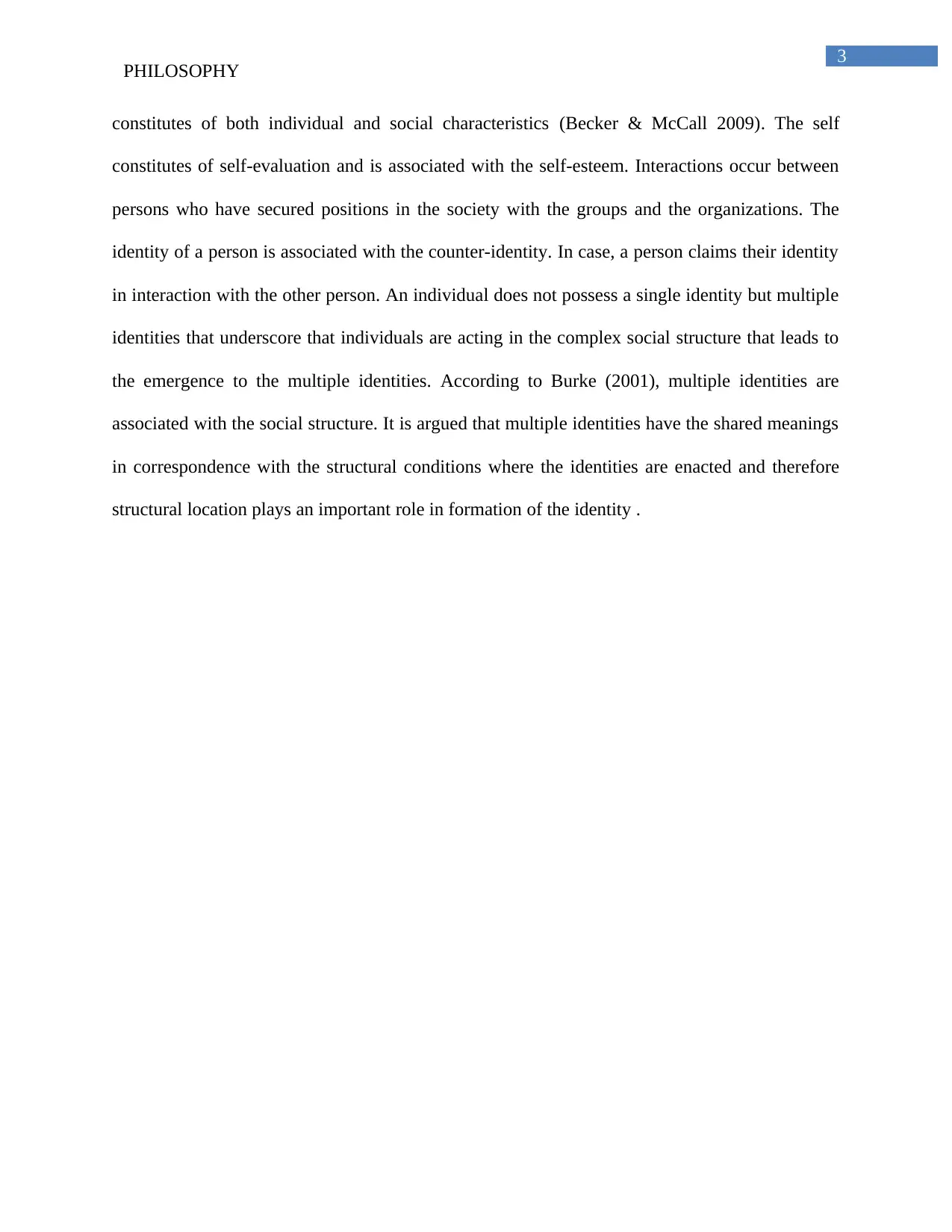
3
PHILOSOPHY
constitutes of both individual and social characteristics (Becker & McCall 2009). The self
constitutes of self-evaluation and is associated with the self-esteem. Interactions occur between
persons who have secured positions in the society with the groups and the organizations. The
identity of a person is associated with the counter-identity. In case, a person claims their identity
in interaction with the other person. An individual does not possess a single identity but multiple
identities that underscore that individuals are acting in the complex social structure that leads to
the emergence to the multiple identities. According to Burke (2001), multiple identities are
associated with the social structure. It is argued that multiple identities have the shared meanings
in correspondence with the structural conditions where the identities are enacted and therefore
structural location plays an important role in formation of the identity .
PHILOSOPHY
constitutes of both individual and social characteristics (Becker & McCall 2009). The self
constitutes of self-evaluation and is associated with the self-esteem. Interactions occur between
persons who have secured positions in the society with the groups and the organizations. The
identity of a person is associated with the counter-identity. In case, a person claims their identity
in interaction with the other person. An individual does not possess a single identity but multiple
identities that underscore that individuals are acting in the complex social structure that leads to
the emergence to the multiple identities. According to Burke (2001), multiple identities are
associated with the social structure. It is argued that multiple identities have the shared meanings
in correspondence with the structural conditions where the identities are enacted and therefore
structural location plays an important role in formation of the identity .
Paraphrase This Document
Need a fresh take? Get an instant paraphrase of this document with our AI Paraphraser
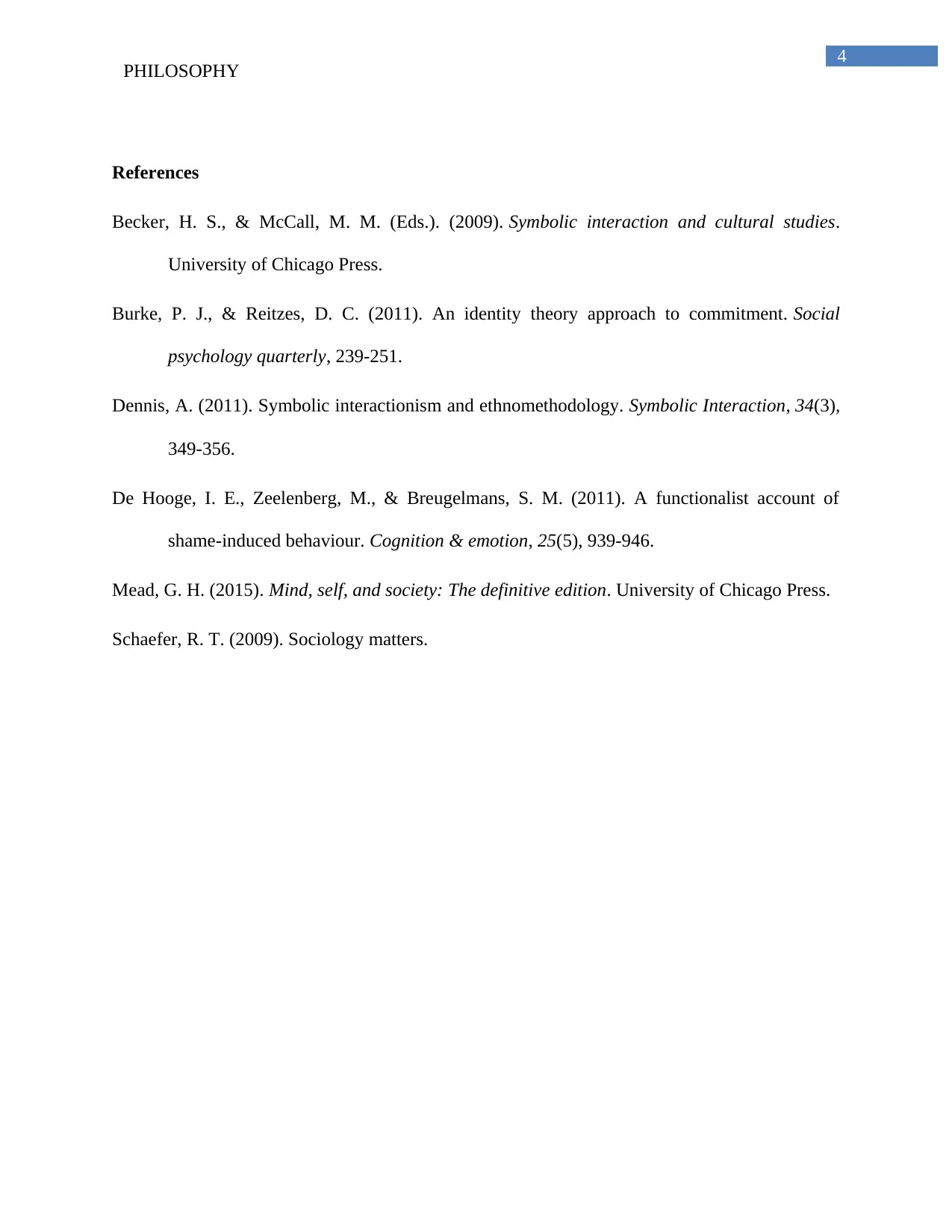
4
PHILOSOPHY
References
Becker, H. S., & McCall, M. M. (Eds.). (2009). Symbolic interaction and cultural studies.
University of Chicago Press.
Burke, P. J., & Reitzes, D. C. (2011). An identity theory approach to commitment. Social
psychology quarterly, 239-251.
Dennis, A. (2011). Symbolic interactionism and ethnomethodology. Symbolic Interaction, 34(3),
349-356.
De Hooge, I. E., Zeelenberg, M., & Breugelmans, S. M. (2011). A functionalist account of
shame-induced behaviour. Cognition & emotion, 25(5), 939-946.
Mead, G. H. (2015). Mind, self, and society: The definitive edition. University of Chicago Press.
Schaefer, R. T. (2009). Sociology matters.
PHILOSOPHY
References
Becker, H. S., & McCall, M. M. (Eds.). (2009). Symbolic interaction and cultural studies.
University of Chicago Press.
Burke, P. J., & Reitzes, D. C. (2011). An identity theory approach to commitment. Social
psychology quarterly, 239-251.
Dennis, A. (2011). Symbolic interactionism and ethnomethodology. Symbolic Interaction, 34(3),
349-356.
De Hooge, I. E., Zeelenberg, M., & Breugelmans, S. M. (2011). A functionalist account of
shame-induced behaviour. Cognition & emotion, 25(5), 939-946.
Mead, G. H. (2015). Mind, self, and society: The definitive edition. University of Chicago Press.
Schaefer, R. T. (2009). Sociology matters.
1 out of 5
Related Documents
Your All-in-One AI-Powered Toolkit for Academic Success.
+13062052269
info@desklib.com
Available 24*7 on WhatsApp / Email
![[object Object]](/_next/static/media/star-bottom.7253800d.svg)
Unlock your academic potential
Copyright © 2020–2025 A2Z Services. All Rights Reserved. Developed and managed by ZUCOL.





